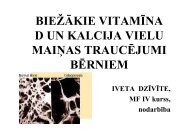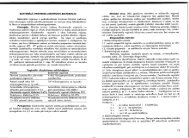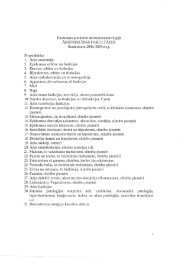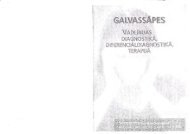PHYSICS
n - susliks.lv
n - susliks.lv
- No tags were found...
Create successful ePaper yourself
Turn your PDF publications into a flip-book with our unique Google optimized e-Paper software.
Hair I •<br />
shaft<br />
Meissner's 1\ ~~,<br />
shaft ..<br />
Sebaceous I~id .,<br />
glands "<br />
Pacinian I I<br />
corpuscles<br />
•<br />
<br />
I Pores<br />
...<br />
I Epidermis<br />
.. Nerve<br />
~·~~~~~;i<br />
,----_/.1: I<br />
~&.llJ<br />
corpuscle<br />
Muscle<br />
\ I Hair<br />
~ folicle<br />
~Sweat<br />
I gland<br />
Blood<br />
vessels<br />
Fig. 5.3. The hair receptor cell<br />
If the head of an animal is<br />
bent at an angle, the semicircular<br />
canals alter their orientation,<br />
while the endolymph remains<br />
at the same place due to<br />
inertia. The deflection of the<br />
otoliths by gravity results in the<br />
transmission of action potentials<br />
by the hair cells to the brain at<br />
about 100 spikes/second. I nterpretation<br />
of the bending by the<br />
brain occurs through the analysis<br />
of changes in the frequency<br />
of the action potentials.<br />
Otoliths<br />
Fig. 5.1. Diagram of the various types of mechanoreceptors in the skin<br />
Fig. 5.2. The vestibular<br />
system in the inner ear which<br />
contains three semicircular<br />
canals, ampullae, an utricle,<br />
and a saccule<br />
Temporal bone of skull<br />
Semicircular ~t<br />
canals<br />
Ampulla<br />
Ampullae<br />
Utricle<br />
Cochlear<br />
"" "duct<br />
Saccule<br />
The utricle is supplied with receptors called hair cells (fig. 5.3).<br />
The cells have several hair-like projections into the endolymph<br />
and are inserted at its base to a gelatinous mass which contains<br />
calcium carbonate crystals called otoliths (fig. 5.4).<br />
34<br />
Fig. 5.4. The receptor<br />
hairs of the utricle and<br />
saccule are clustered in<br />
the region called the<br />
macula; their gelatinous<br />
masses contain calcium<br />
carbonate crystals<br />
called otoliths<br />
Macula<br />
5.1.3. Proprioception<br />
Hair cells<br />
Basement<br />
membrane<br />
Proprioception indicates the relative positions of various parts<br />
of the body without having to use the eyes. There are two important<br />
receptor systems in the skeletal muscles of mammals: the<br />
muscle spindle and the Golgi tendom organ.<br />
The muscle spindles are arranged in parallel to the contracting<br />
skeletal muscle fibers. The spindles respond to the relative elongation<br />
of the muscle (fig. 5.5). Elongation is transferred by the<br />
35






